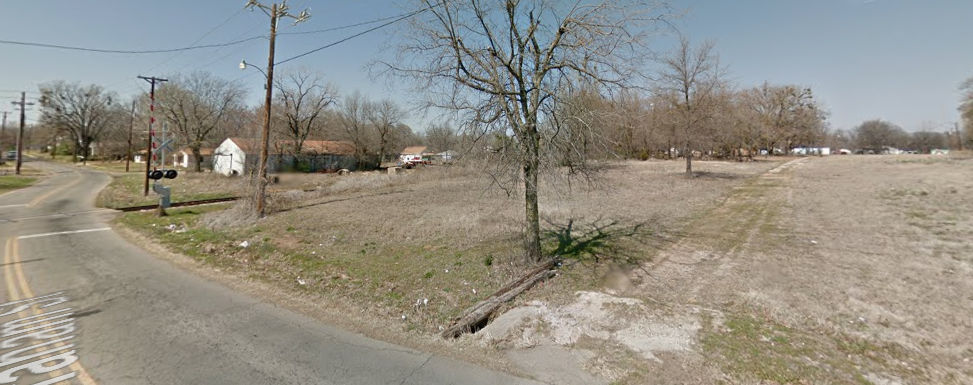Texas Railroad History - Tower
79 - Paris
A Crossing of the Texas & Pacific,
the Texas Midland, the Gulf,
Colorado & Santa Fe, and the Paris & Great Northern Railroads
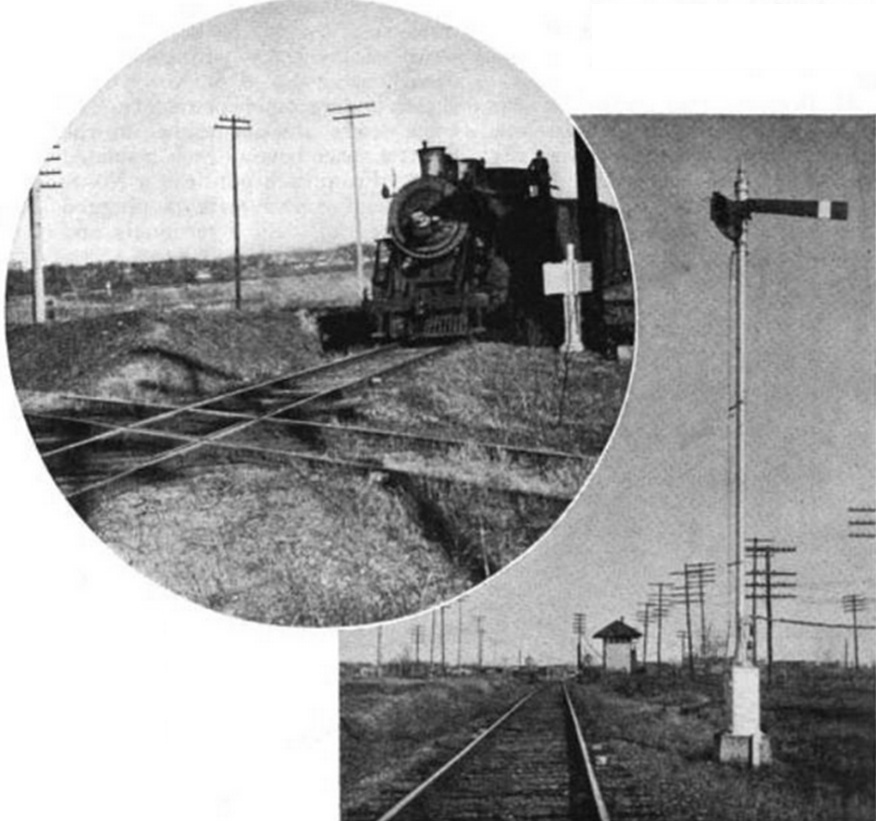
Above: The July, 1936
issue of Railway Signaling and Communications
contained an article about the conversion of the manual interlocker at Tower 79
into an automated system. The article opened with this image showing a home
signal on the Texas & Pacific (T&P) tracks with the tower in the distance and an
inset showing one of the crossing diamonds at the junction. Since the tower was
south of the T&P tracks, this view faces east. The article states
that all of the work required for installing the new system and modifying
the track signals was performed by T&P signal forces. This suggests that Tower 79 was
designed and built by the T&P. This is the only
photograph of Tower 79 that has been located (hat tip, Barton Jennings.)
The town of Paris was founded in 1844 by George Wright,
a merchant and landowner in the area. The community quickly became the county
seat of Lamar County and was officially named for the great French capital, the name being chosen by one of Wright's employees.
In 1873, the Texas & Pacific (T&P) Railway built 54 miles east from
Sherman to within nine miles of Paris. Two years
later, the remaining nine miles was completed and Paris had its first rail
service. Although the T&P was chartered by Congress in 1871 (the only such
railroad in Texas) with the purpose of building a southern transcontinental
line, it was following a route strategy in Texas that had been established earlier by the
Texas Legislature when it created charters for the predecessor companies
that had been acquired by the T&P. Those charters called for completion of two
lines between Texarkana and Ft. Worth: a southern route via Marshall and a
northern route paralleling the Red River to Grayson County and then southwest to
Ft. Worth. From Ft. Worth, a single main line
would be built to El Paso. In 1876, the remaining 90 miles between Paris and
Texarkana was finished and Paris became a major stop for the T&P. Continuing the original plan, the T&P built tracks from Sherman
to Ft. Worth in 1880 to complete the northern route.
In 1886, the Gulf,
Colorado & Santa Fe (GC&SF) Railway began building tracks out of
Dallas toward Paris. This route was part of an
agreement wherein the much larger Atchison, Topeka & Santa Fe (AT&SF) Railway
would acquire the GC&SF as a wholly owned subsidiary once the GC&SF had finished
specific construction efforts. The line was completed and the acquisition
occurred in 1887; the GC&SF continued operating under its own name as a
subsidiary of the AT&SF. Santa Fe viewed Paris as a valuable location to serve
because in 1880, the St. Louis San Francisco ("Frisco") Railway had begun
building tracks between Monett, Missouri and Hugo, Indian
Territory (Oklahoma) via Ft. Smith, Arkansas with an objective to extend the Frisco's
routes from the midwest into Texas. This included a plan to bridge the Red River
south of Hugo about fifteen miles north of Paris. Santa Fe anticipated
cooperatively handling Frisco traffic
from the midwest via Paris to
Dallas and points south. Frisco's Red River bridge opened in 1888 and that same
year, the Frisco sponsored the charter of the Paris & Great Northern (P&GN) Railroad
to build seventeen miles of track between Paris and the
bridge. The separate charter was a necessity to comply with Texas' law which
required railroad companies to be headquartered in the state. The P&GN was
then built and operated by the
Frisco.
Santa Fe was not the first to see the
economic potential of the Frisco's plan to build into Hugo and bridge the Red River. The
Houston & Texas Central (H&TC) Railway envisioned an interchange at Paris
as an alternate means of connecting Houston and
Galveston with midwest commerce
via the Frisco's lines while also bringing in cotton freight from northeast Texas
for export. The H&TC had completed its main line between Houston
and the Red River at Denison in 1873 where it was
exchanging midwest traffic with the Missouri Kansas Texas ("Katy") Railroad.
H&TC's investors had begun to look for opportunities to build traffic-generating
branch lines and they elected to do so
under a new charter, the Texas Central (TC) Railway Co. In addition to
construction of a northwest branch out of Ross (which was essentially an
extension of the H&TC's existing branch to Waco), the TC began
building
a northeast branch from the H&TC main line at Garrett, near Ennis, in 1882. The tracks
passed through Kaufman and Terrell and continued north to Roberts in 1884, a
small community south of Greenville.
There, the track sat ... operational but
mostly dormant ... for ten years as the TC went through a receivership (as did
the H&TC.) Southern Pacific (SP) ended up owning the H&TC, but they passed on
the opportunity to buy the TC. Instead, when all the financial dust settled, the
Roberts branch of the TC had been acquired by Hetty Green, a wealthy New York
investor who sent her son Edward H. R. Green to look after her Texas railroad
interests (which had included original investments in the H&TC and the TC.) E.
H. R. Green chartered the Texas Midland (TM) Railroad to consolidate his
mother's rail and land interests in Texas including the 52 miles of track from
Garrett to Roberts. The TM proceeded to build its own 4-mile track from Garrett
to Ennis in 1894 and then built 19 miles of track from Roberts to Greenville in
1895. At Greenville, the TM could connect with the Katy, the St. Louis
Southwestern ("Cotton Belt") Railway, and the Sherman, Shreveport & Southern
(SSS) Railway which had acquired a line between Jefferson and McKinney in 1893 after a lawsuit forced the Katy to divest
it. These tracks had originally been built by the East Line & Red River Railroad
but had been acquired by the Katy in a transaction that was later ruled invalid.
The various interchanges at Greenville and the connection to the H&TC
at Ennis combined to produce at least a little traffic for the TM while Green
decided how to proceed. Green was only 27 at the time and in ultimately choosing
to build north from Greenville to Paris, he relied on the advice of B. F. Yoakum, a 36-year old rising star
among Texas railroad executives who would soon become the General Manager of
the Frisco. (The Tower 2 and
Tower 80 descriptions have much more on Yoakum's
exploits in Texas.) Green's effort to reach Paris began by procuring rights to
use the Cotton Belt's existing tracks between Greenville and Commerce (in 1921,
the TM would drop these rights and build its own line to Commerce on a
right-of-way that is now mostly occupied by Highway 224.) From Commerce, the TM
built 37 miles north to Paris, arriving in 1896. Yoakum's advice proved both prescient
and self-serving; the TM's tracks provided an efficient connection
between the Frisco and the H&TC for traffic to south Texas. Soon, the Frisco,
the H&TC and the TM combined to run first class passenger service between St.
Louis and Houston with the Ennis - Paris segment operated by the TM.
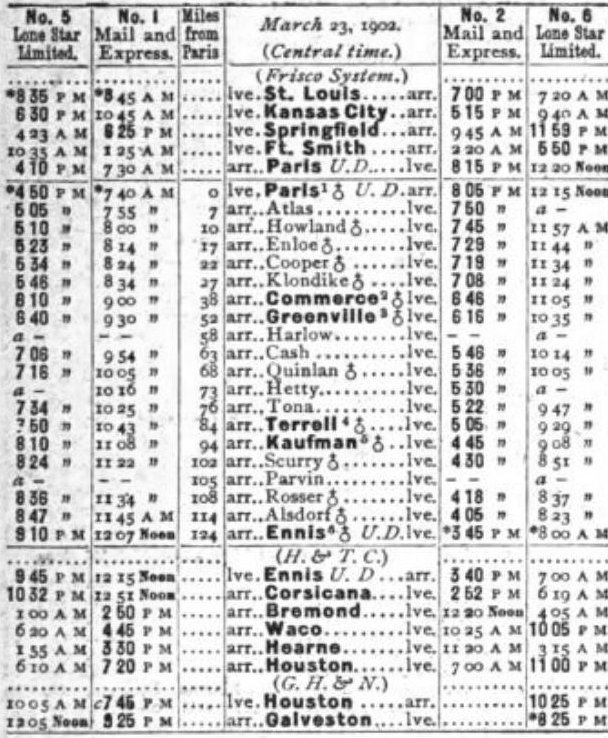 |
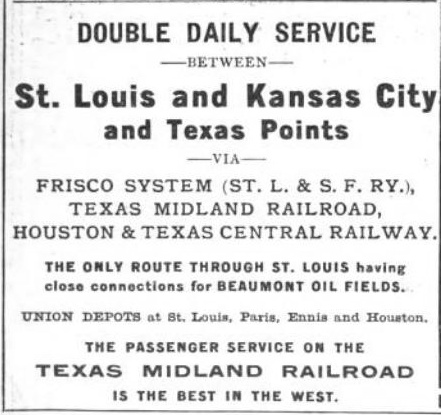
In July,
1902, the Official Railway
Guide had this Texas Midland ad for Lone
Star Limited passenger trains. It mentions the Union Depot at
Paris, which was the Frisco depot that preceded Union Station. |
The TM was successful for many years due to the
leadership of E. H. R. Green. Reputed to have brought the first automobile
into the state, he also brought various innovations to Texas
railroading including electric headlights for locomotives and a better type of
grade ballast. But
his most significant contribution to Texas was his 1903 provision of land and funding
for a test farm to pioneer new cotton varieties and farming methods to combat
the boll weevil which was wreaking havoc on cotton crops throughout the state. Cotton was the cream
of the Texas freight business and the most valuable commodity moved by the TM.
His test farm, under the direction of scientists from Texas A & M, was a
success and led to the introduction of the County Extension Agent program across
the state. Colonel Green (as he became known in 1910 with an honorary
appointment to the Governor's staff) eventually returned to New York and sold the TM
to SP in 1928.
According to its 1910 Annual Report, March 28, 1909 was
the date the Railroad Commission of Texas (RCT) authorized Tower 79 to begin
operation on the southwest side of Paris. It
housed a 32-function electric interlocker that officially served four
railroads: the T&P, the GC&SF, the TM and the P&GN (Frisco). RCT's 1911
Annual Report revised the commissioning date to May 27, 1909, and the 1924
Annual Report
reduced the interlocker function count to 26 (for reasons undetermined.) The 1930 Annual Report ceased listing the P&GN
as a participant at Tower 79 and replaced it
with "StLSF&T" - the St. Louis San Francisco and Texas Railway. State
law required railroads operating in Texas to have their headquarters in state,
so the StLSF&T was created as a subsidiary into which the Frisco could
consolidate its Texas properties including the P&GN. RCT's 1931 Annual Report, the last one to incorporate a table of
interlocker details, reduced the function count of Tower 79 to 25, reflecting an
undetermined change. It also inexplicably reverted to listing the P&GN as a
participating railroad instead of the StLSF&T.
A fifth railroad began construction at Paris
in 1909, the Paris & Mt. Pleasant
(P&MP) Railroad. The idea for the P&MP was to connect with the Cotton Belt at
Mt. Pleasant to gain an additional transportation outlet to the east. But among
local investors, the real impetus was to provide transportation into
southeastern Lamar County. In the winter when the black soil mixed with heavy
rain to make the roads impassable, communities were literally cutoff from
reaching Paris for weeks at a time. The townspeople of Pattonville, Deport and
Bogata had long lobbied Paris business leaders for a railroad so they could survive the winter months "when
the mud came". The P&MP began operating as far as Bogata in 1910 and reached Mt.
Pleasant in 1912. Its tracks at Paris approached the vicinity of Tower 79 to
serve various businesses and to exchange traffic with other railroads, but it
was not directly involved with the interlocker.
Like the T&P, the P&MP had its
own depot on the south side of Paris. As for the other
three railroads, construction of a Union Station was motivated by the fact that Santa Fe and the TM
each had arrangements with the Frisco for through passenger service at Paris. The station
opened in 1910 and was located about 8/10ths of a mile north of Tower 79 west of
downtown Paris.
At the time, Paris had grown to a population of over 11,000 residents.
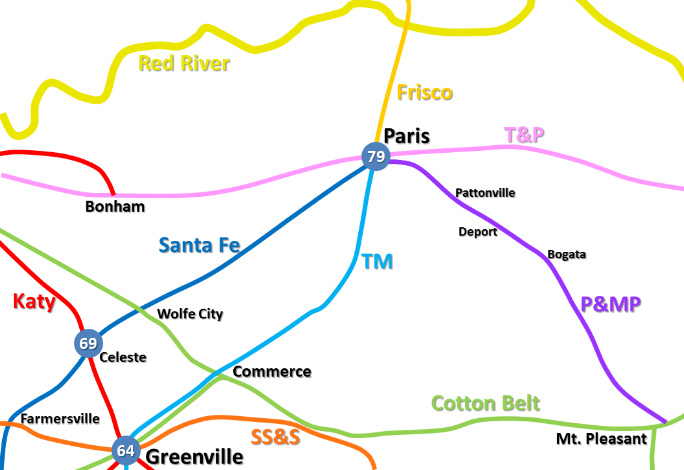 |
Left:
This map shows rail lines in the vicinity of Paris with interlocking
towers identified by number. Because lines changed ownership over time,
this map does not represent any particular date, and more than half of
the lines are now
abandoned. Tower 64 remains partly intact,
but Towers 69 and 79 have been razed.
Commerce, Farmersville, Wolfe City, Bonham and Mt. Pleasant had
crossings or junctions without numbered interlockers (but some may have been controlled
by
gates.)
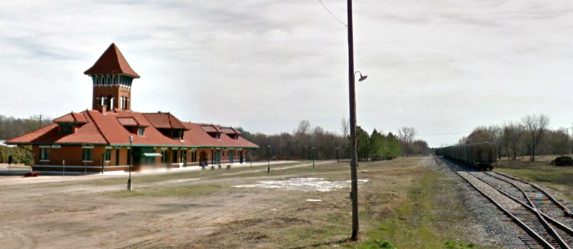
Above:
The open area between
Paris Union Station and the
main track west of the depot was historically used for passenger tracks
(note poles for platform lighting still in place.) This view is to the south from the Bonham St. grade crossing. The
station now hosts the Valley of the Caddo Museum and Cultural Center.
(Google Street View, March 2013) |
By the early 1930s, railroading had changed
considerably throughout the state with company consolidations, new technology and revised operating
methods.
On May 1, 1930, RCT authorized the
first automated interlockers in Texas and
simultaneously eliminated the requirement for derails at automated crossings.
Railroads began to examine their interlocker locations where the new technology
might be
deployed to reduce the labor and maintenance costs of manned
towers. The railroads at Paris decided that Tower 79 was such a
location and the T&P took the lead on the project in 1933. A comprehensive
technical article in the July,
1936 edition of Railway Signaling and
Communications explained the rationale for the change:
At present, the traffic on the
Southern Pacific consists of one freight train in each direction daily and a
local passenger train, a light motor. The Santa Fe traffic is the same as the S.
P. as is also the T. & P., which, however, includes a steam passenger train
rather than a motor. The Frisco and the Santa Fe, on the other hand, operate one
through passenger train between St. Louis and Dallas, via Ft. Smith, Ark. and
Paris, and in addition, the Frisco handles considerable yard work in the
vicinity of the interlocking. Automatic operation of the signals is highly
advantageous for these switching operations as the necessity for flagging over
the crossings is obviated. Furthermore, the extent of these operations does not
warrant a manually-controlled interlocking.
As of 2021, the only rail service to Paris is provided
by the Kiamichi Railroad using the former Frisco rails out of Hugo. The tracks
were acquired from the Frisco's successor Burlington Northern in 1987. Service is
also provided by Kiamichi a short distance past the Tower 79 site to serve a
business along the former Santa Fe tracks. South of there, the Santa Fe line to
Dallas was abandoned between Paris and Farmersville in 1995 and is being used as
a public trail. The T&P line is abandoned east of Paris
towards Texarkana, much of the right-of-way having been converted to a public
trail. To the west, the T&P line is out of service to Bonham and beyond. The
tracks remain mostly intact although they're completely overgrown and the grade
crossings have been removed. The Texas
Midland was abandoned in 1975 and the rails were removed shortly thereafter. The
P&MP was abandoned in 1956. The result of all of these abandonments is that
Paris is no longer directly connected to the rail network in Texas.
Below:
This 1946 index map from the Sanborn Fire Insurance Co. has been annotated to
show the location of Tower 79 and Paris Union Station. Three railroads are
clearly labeled on the original map, including the Texas & New Orleans (T&NO),
SP's operating company for Texas and Louisiana which took over the TM route. In addition to
the Frisco track for which a label has been added, Frisco also owned the
industry spur along Frisco Avenue. At lower right, an industry track for the
P&MP extends west to join a connecting track from the T&NO.
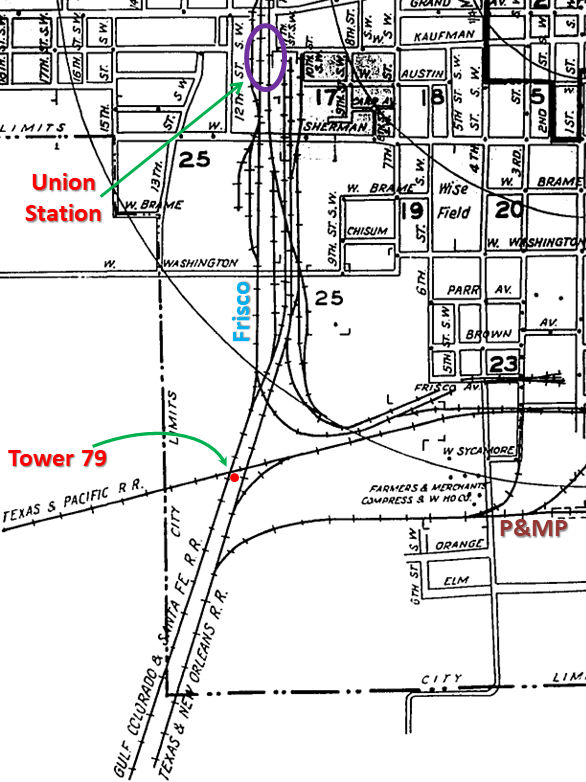 |
Below: This 1957 aerial
image ((c)HistoricAerials.com) shows Tower 79 casting a distinct shadow across
the T&P tracks. The tower is reported to have been dismantled in 1963,
with remaining interlocker equipment moved to trackside cabinets. The
visibility of trackside utility poles and signal structures at this
angle suggests this was mostly open prairie in 1957.

Below: T&NO
Employee Timetable #33 issued June 2, 1940 explained how to override the automatic interlocker at Paris should it not properly issue a PROCEED indication.
The T&P crossing control box was at the "southwest corner of tower
building" (which was no longer staffed after 1933.) The control box for the
crossing of the Frisco spur north of the tower was on a post at the
"southwest intersection" of the crossing.
 |
In January, 2005, Myron Malone took these photos
when he hiked out to the site of Tower 79.
Below Left: This view looks northeast across the diamond for
the Santa Fe tracks (lower right corner) and the T&P tracks (lower left corner.)
The T&P tracks pass the line of cedar trees to the right heading east
toward the T&P depot. Tower 79 would have been just out of
view to the right. Below Right:
Looking southeast, Tower 79's foundation is located across the diamond just
beyond the short cedar
trees.
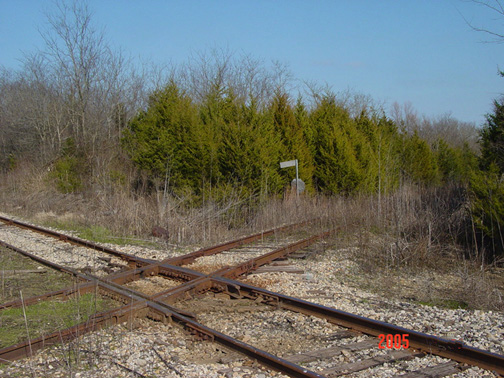
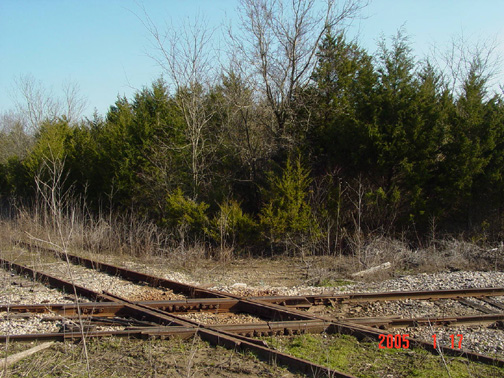
Below
Left: This view is to the north along the Santa Fe tracks. Union
Station is approximately 0.8 miles distant. The T&P line crosses left to right.
Tower 79 was to the right, behind the red sign.
Below Right: The foundation of Tower 79 remains in place
amidst the cedar trees on the southeast side of the diamond. Two concrete
steps for the tower are visible on the far side of the foundation. Whether
these led to the staircase or perhaps an access door for the lower floor is
unknown.
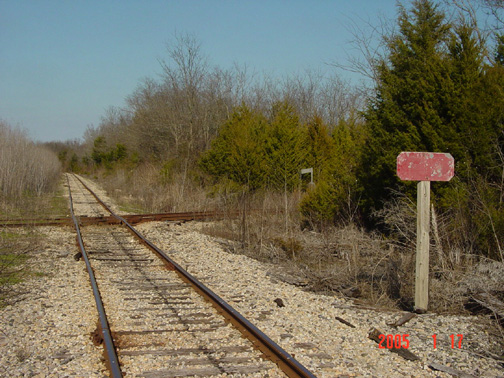
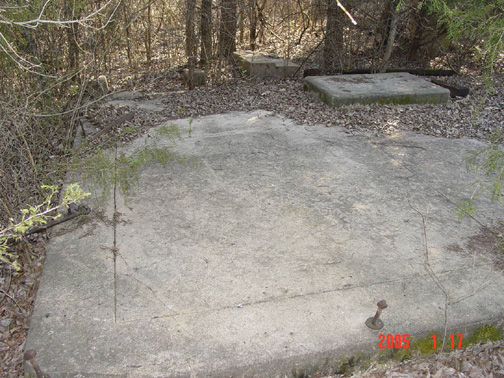
Below Left: This is the view of the foundation from its
northwest corner. Below Right:
At the south side of the tower foundation, steps and pillow blocks for lever
connections to switches and signals are still present.
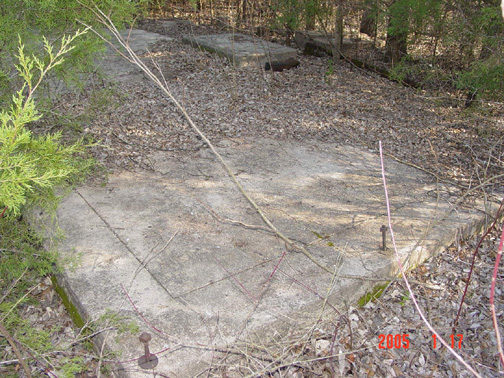
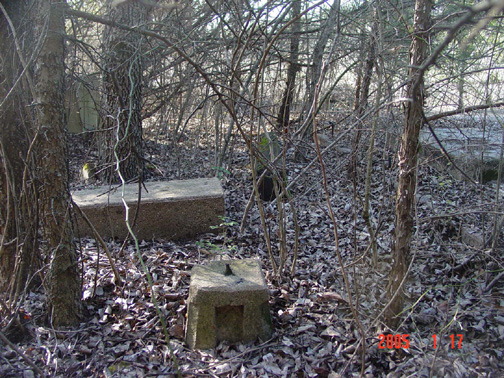
Tower 79 Crossing, Bird's Eye View Looking South
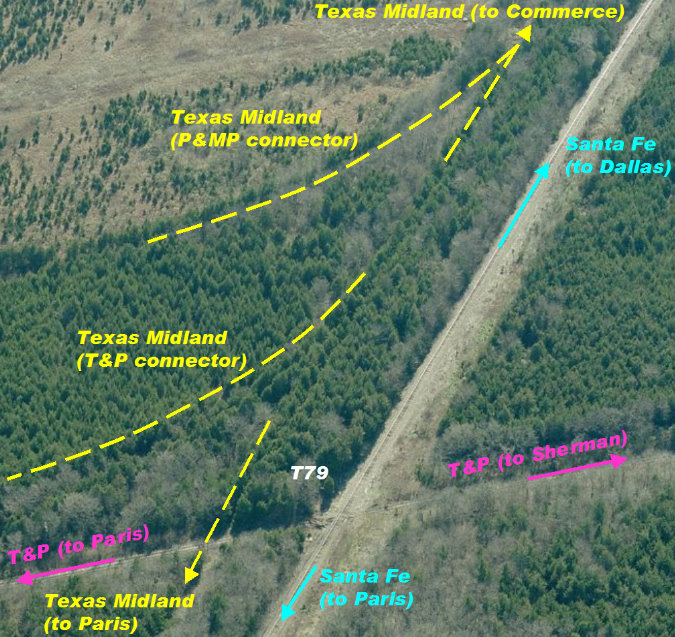
Above: Despite being
overtaken by dense vegetation (in stark contrast to the 1957 aerial imagery), telltale signs of additional rights-of-way are
visible near the site of Tower 79 in this bird's eye view c.2008. The TM crossing of the T&P is readily
visible, and the outlines of the TM connectors
to the T&P and the
P&MP can also be discerned. Although the former T&P tracks remain intact in this image, the diamond
has been removed and debris sits across the tracks east of the crossing, a
change since the 2005 images above. The
former Santa Fe
tracks are in use by Kiamichi
Railroad for a business farther south.
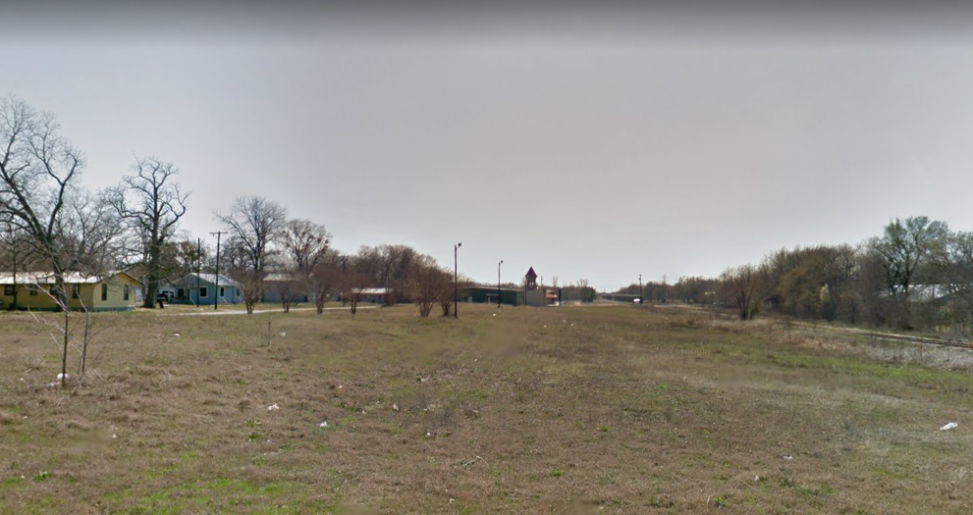
Above: Looking south from
Graham St., the tower atop Paris Union Station is readily visible. The former
Frisco main line is at far right. The obvious wide right-of-way carried multiple
tracks at different times.
Below: Looking
north from the Graham St. grade crossing, the former Frisco main line is at far
left, still in use. In the immediate foreground, the former Santa Fe
right-of-way is apparent as it continued north across Graham St. and curved east
in the distance. Santa Fe's first Paris depot was located at the end of this
track. When Santa Fe relocated to Union Station, the track remained intact to
serve businesses. (both images courtesy Google Street View, March 2013)
